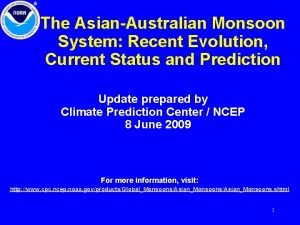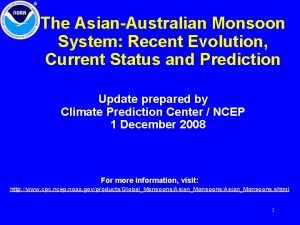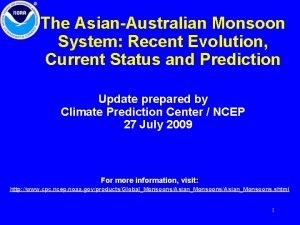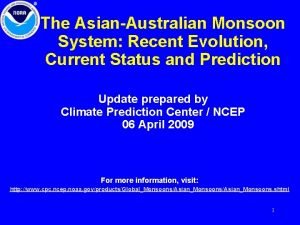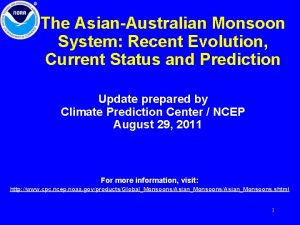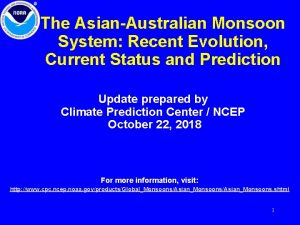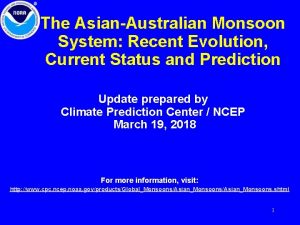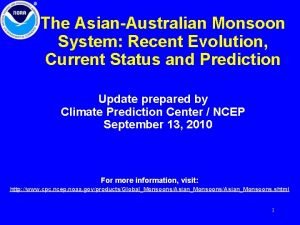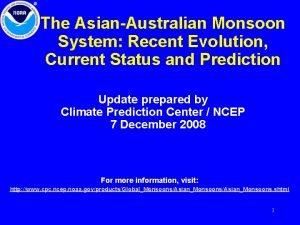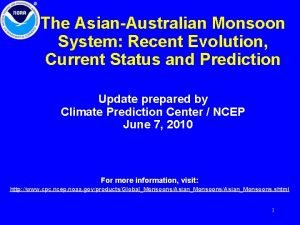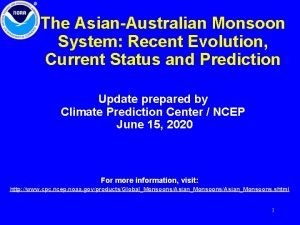The AsianAustralian Monsoon System Recent Evolution Current Status












- Slides: 12

The Asian-Australian Monsoon System: Recent Evolution, Current Status and Prediction Update prepared by Climate Prediction Center / NCEP January 02, 2012 For more information, visit: http: //www. cpc. ncep. noaa. gov/products/Global_Monsoons/Asian_Monsoons. shtml 1

Outline • Recent Evolution and Current Conditions • Monsoon Prediction • Summary • Climatology 2

Precip Patterns: Last 90 Days During the last 90 days, the accumulated dryness that was observed over much of India and eastward onto Bangladesh, and parts of Thailand Laos and even over parts of eastern China continues. Overall, during this period, south Asia is somewhat below normal and southeast Asia and eastern Australia is relatively above normal. 3

Precip Patterns: Last 30 Days The 30 -day precipitation anomaly pattern is marked by a small pocket of significant negative anomaly over southeast China and relatively large positive anomalies over eastern Australia (except for the northwest) and Philippines. Elsewhere, the 30 day precip amounts are near normal. 4

Precip Patterns: Last 7 Days This past week, normal to above normal rainfall fell over much of southeast Asia and relatively normal to below normal rainfall over southern India and much of northern Australia. As predicted and as alluded to in last week’s discussion, Topical Cyclone Thane wrecked havoc and brought lots of rain to southern part of India, particularly the state of Tamil. Nadu and also to southern Andhra Pradesh and parts of Kerala. 5

Rainfall Time Series over 5 x 5 lat-lon boxes Note: This unified land-only daily precipitation dataset is different from the CMAP dataset used in the previous three spatial maps. The time series of precipitation over the various regions is relatively consistent with the spatial maps shown earlier. 6

Atmospheric Circulation The impact of Tropical Cyclone Thane near the southeast coast of India is evident as well as the anomalous southeast to northwest inflow of moisture (and rain) from the Bay of Bengal into central and northern India, which decreased the monthly deficit of rainfall in these regions. 7

NCEP/GFS Model Forecasts Bias-Corrected Precip. Anom. for Weak 1 & Week 2 Week-1 Week-2 8

Summary • During the last 90 days, the accumulated dryness that was observed over much of India and eastward onto Bangladesh, and parts of Thailand Laos and even over parts of eastern China continues. Overall, during this period, south Asia is somewhat below normal and southeast Asia and eastern Australia is relatively above normal. The 30 -day precipitation anomaly pattern is marked by a small pocket of significant negative anomaly over southeast China and relatively large positive anomalies over eastern Australia (except for the northwest) and Philippines. Elsewhere, the 30 day precip amounts are near normal. • This past week, normal to above normal rainfall fell over much of southeast Asia and relatively normal to below normal rainfall over southern India and much of northern Australia. As predicted and as alluded to in last week’s discussion, Topical Cyclone Thane wrecked havoc and brought lots of rain to southern part of India, particularly the state of Tamil. Nadu and also to southern Andhra Pradesh and parts of Kerala. In the circulation fields, the impact of Tropical Cyclone Thane near the southeast coast of India is evident as well as the anomalous southeast to northwest inflow of moisture (and rain) from the Bay of Bengal into central and northern India, which decreased the monthly deficit of rainfall in these regions. The NCEP GFS model is predicting below normal rainfall to southern India, Sumatra, and northern parts of Australia and near to above normal rainfall elsewhere in the monsoon region in the upcoming two weeks. 9

Demise of the Asian Monsoon 10

Onset of the Australian Monsoon 11

Climatology 12
 A balanced delta connected load having an impedance 20-j15
A balanced delta connected load having an impedance 20-j15 Power formula three phase
Power formula three phase N=nc exp(-eg/2kt)
N=nc exp(-eg/2kt) Lesson 4 three-phase motors
Lesson 4 three-phase motors Drift current and diffusion current in semiconductor
Drift current and diffusion current in semiconductor Intrinsic semiconductor
Intrinsic semiconductor Q point
Q point Delta to wye conversion balanced
Delta to wye conversion balanced Slideplayer
Slideplayer Drift current and diffusion current in semiconductor
Drift current and diffusion current in semiconductor All of the heat produced by sma weld stays in the weld.
All of the heat produced by sma weld stays in the weld. Hazard based safety engineering
Hazard based safety engineering Non planar circuit
Non planar circuit













